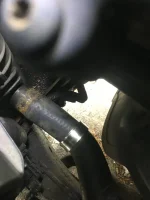The clamp ends. where the ears are, rusted and seized on the hose and thus could not move to accomodate the shrinking of the plastic hose barb in cold temperatures.
I had a bit of coolant loss last winter and I posted about it
https://bobistheoilguy.com/forums/threads/inexplicable-coolant-loss.358567/#post-6206801
Spring clamp goes on the lower rad hose at the rad on my Sierra. I had taken this clamp off twice before for coolant replacement, once in 2011 and once in 2019. Rad has no drain, so this is how I drain the coolant. I always put them back on in the exact same position it was when it left the factory.
I could not figure out where the leak was last winter and the leak stopped once temps warmed up a bit. Last Friday, when it was really cold at -20C, I came out of Costco with my groceries and there was puddle of coolant under the front of my truck. Opened the hood and saw the leak from the bottom rad hose. Nothing I could do in the parking lot, so I just loosened the surge tank cap so the the cooling system was not under pressure, verified that there was enough coolant for operating the engine and went about my day.
On Sunday I used my OTC tool to expand the clamp. I had to use wood clamps to get enough leverage to open up the spring clamp fully and engage the built in catch on the spring clamp and thus stay expanded. Access was limited and I had to reach in from the top. When I tried to move the clamp, I noticed it was seized on to the hose where the clamp ears are. After struggling to move it for a bit, I gave up because I did not want to risk cracking the plastic hose nipple on the rad. Got my Dremel and cut the clamp off. I used two clamps this time, a Mikalor wide band T-bolt and a constant tension Belleville washer clamp.



I had a bit of coolant loss last winter and I posted about it
https://bobistheoilguy.com/forums/threads/inexplicable-coolant-loss.358567/#post-6206801
Spring clamp goes on the lower rad hose at the rad on my Sierra. I had taken this clamp off twice before for coolant replacement, once in 2011 and once in 2019. Rad has no drain, so this is how I drain the coolant. I always put them back on in the exact same position it was when it left the factory.
I could not figure out where the leak was last winter and the leak stopped once temps warmed up a bit. Last Friday, when it was really cold at -20C, I came out of Costco with my groceries and there was puddle of coolant under the front of my truck. Opened the hood and saw the leak from the bottom rad hose. Nothing I could do in the parking lot, so I just loosened the surge tank cap so the the cooling system was not under pressure, verified that there was enough coolant for operating the engine and went about my day.
On Sunday I used my OTC tool to expand the clamp. I had to use wood clamps to get enough leverage to open up the spring clamp fully and engage the built in catch on the spring clamp and thus stay expanded. Access was limited and I had to reach in from the top. When I tried to move the clamp, I noticed it was seized on to the hose where the clamp ears are. After struggling to move it for a bit, I gave up because I did not want to risk cracking the plastic hose nipple on the rad. Got my Dremel and cut the clamp off. I used two clamps this time, a Mikalor wide band T-bolt and a constant tension Belleville washer clamp.




Last edited:
